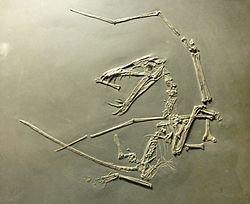Dorygnathus
|
Dorygnathus Temporal range: Early Jurassic, 180 Ma |
|
|---|---|
 |
|
| A cast of UUPM R 156 in Göteborgs Naturhistoriska Museum, a specimen sold by Bernhard Hauff to the University of Uppsala in 1925 | |
| Scientific classification | |
| Kingdom: | Animalia |
| Phylum: | Chordata |
| Class: | Reptilia |
| Order: | †Pterosauria |
| Family: | †Rhamphorhynchidae |
| Subfamily: | †Rhamphorhynchinae |
| Genus: |
†Dorygnathus Wagner, 1860 |
| Type species | |
|
†Ornithocephalus banthensis Theodori, 1830 |
|
| Species | |
|
†Dorygnathus banthensis |
|
| Synonyms | |
|
|
†Dorygnathus banthensis
(Theodori, 1830)
Dorygnathus ("spear jaw") was a genus of pterosaur that lived in Europe during the Early Jurassic period, 180 million years ago when shallow seas flooded much of the continent. It had a short 1.5 meters (4.9 feet) wingspan, and a relatively small triangular sternum, which is where its flight muscles attached. Its skull was long and its eye sockets were the largest opening therein. Large curved fangs that "intermeshed" when the jaws closed featured prominently at the front of the snout while smaller, straighter teeth lined the back. Having variable teeth, a condition called heterodonty, is rare in modern reptiles but more common in primitive pterosaurs. The heterodont dentition in Dorygnathus is consistent with a piscivorous (fish-eating) diet. The fifth digit on the hindlimbs of Dorygnathus was unusually long and oriented to the side. Its function is not certain, but the toe may have supported a membrane like those supported by its wing-fingers and pteroids. Dorygnathus was according to David Unwin related to the Late Jurassic pterosaur, Rhamphorhynchus and was a contemporary of Campylognathoides in Holzmaden and Ohmden.
Dorygnathus in general has the build of a basal, i.e. non-pterodactyloid pterosaur: a short neck, a long tail and short metacarpals — although for a basal pterosaur the neck and metacarpals of Dorygnathus are again relatively long. The skull is elongated and pointed. The largest known cranium, that of specimen MBR 1920.16 prepared by Bernard Hauff in 1915 and eventually acquired by the Humboldt Museum in Berlin, has a length of sixteen centimetres. In the skull the eye socket forms the largest opening, larger than the fenestra antorbitalis that is clearly separated from the slit-like bony naris. No bony crest is visible on the rather straight top of the skull or snout. The lower jaws are thin at the back but deeper toward the front where they fuse into the symphysis ending in a toothless point after which the genus has been named. In MBR 1920.16, the mandibula as a whole has a length of 147 millimetres.
...
Wikipedia
